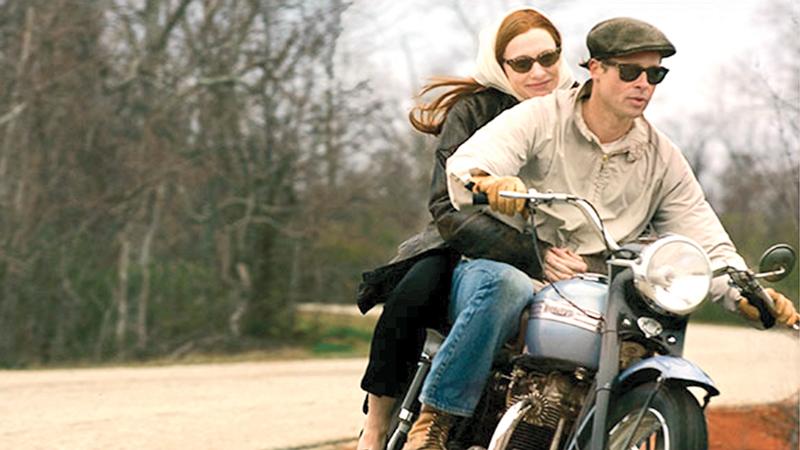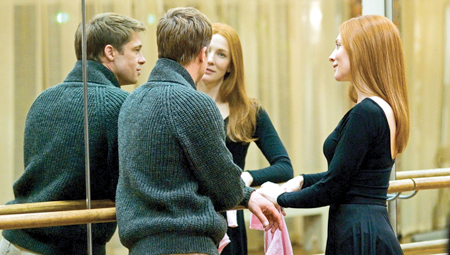
The fantasy element in F. Scott Fitzgerald’s 1922 short story, The Curious Case of Benjamin Button, in which a man ages backwards, does not begin to suggest the urgent drama and romantic fatalism that director David Fincher and writers Eric Roth and Robin Swicord have so strikingly brought to the screen in the movie version. Fitzgerald’s story is little more than a plot gimmick. Yet the film transforms this gimmick into an epic tale that contemplates the wonders of life -- of birth and death and, most of all, love.
 Superbly made and winningly acted by Brad Pitt in his most impressive outing to date, the audience for this Paramount/Warner Bros. co-production is large. Strong box office ensued back in late 2000s’.
Superbly made and winningly acted by Brad Pitt in his most impressive outing to date, the audience for this Paramount/Warner Bros. co-production is large. Strong box office ensued back in late 2000s’.
Although hard to pigeonhole, the picture comes closest to Latin American magic realism, which juxtaposes the fantastic with the realistic. The film shares elements with another Eric Roth-written film, Forrest Gump, wherein a most unusual man sets out on an odyssey through 20th century American history. But Fincher, an unusual but winning choice as director, makes certain that Benjamin Button has none of the whimsy or coy historical revisionism of Forrest Gump.
Framework
Even the framework for the story underscores that there are forces within nature that man cannot control. Daisy (Cate Blanchett), a dying woman in a New Orleans hospital, gives her daughter (Julia Ormond) a memoir to read as Hurricane Katrina bears down on the city. The memoirist is none other than Benjamin (Pitt), born on the day of victory in Europe in 1918.
He was, he writes, “born under unusual circumstances.” He’s a baby that looks like a failing man in his 80’s with poor eyesight, brittle bones and wrinkled flesh. His mother dies giving birth and his father (Jason Flemyng) abandons him, fittingly, at an old-age home. A maternal black woman, Queenie (Taraji P. Henson), who runs the place, takes him in and raises him in the one environment where he can pass unnoticed.
He truly fits in among African-Americans and people old and forgotten by time. Everyone is an outsider here. As a somewhat younger old man, he meets Daisy as a small girl (Elle Fanning) visiting an ancient relative. Their friendship will last both of their lifetimes -- although ones moving in opposite directions -- and will evolve into romance and passionate love.
Daisy and Benjamin
 Much keeps them apart though as Daisy pursues a career in ballet while Benjamin, once he gets a handle on what’s happening to him, is a man who will never feel comfortable in his own skin. The job on a tug boat with its hard-drinking pilot (Jared Harris) takes him to Russia and an affair with a British spy’s wife (Tilda Swinton) and then into naval action in World War II.
Much keeps them apart though as Daisy pursues a career in ballet while Benjamin, once he gets a handle on what’s happening to him, is a man who will never feel comfortable in his own skin. The job on a tug boat with its hard-drinking pilot (Jared Harris) takes him to Russia and an affair with a British spy’s wife (Tilda Swinton) and then into naval action in World War II.
After the war, Daisy’s career takes off. Also she can’t quite make up her mind about involvement with a man growing younger each year. But when commitment comes, contentment, brief though it may be, ensues.
Benjamin’s story is preceded by Daisy’s recollection of a watch maker (Elias Koteas), who having lost his beloved son in World War I made a clock for the New Orleans train station that ran backwards so that time might move the same way and his boy would come back to him. Thus, narratively and thematically, the film positions time-running-backward as part of man’s eternal desire to cheat death and to cling to those closest to us.
Touching and poignant
Pitt’s Benjamin is a touching and poignant figure, a person often lost within his own life but with a comic spirit that allows him to accept his backward fate. Blanchett illuminates the screen with a beauty and intelligence that makes Benjamin’s pursuit of Daisy as much a quest for life as for love. As the adoptive mother, Henson embodies the essence of a good woman who derives her strength from God and her instincts from common sense.
Fincher’s direction is sure handed over the entire 166 minutes, which never feels long or pretentious. The film takes Donald Graham Burt’s brilliant period design in stride, never overemphasising it nor lingering on an artifact. Claudio Miranda’s cinematography wonderfully marries a palette of subdued earthen colours with the necessary CGI and other visual effects that place one in a magical past.
